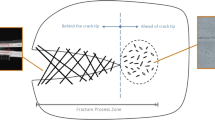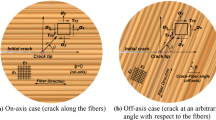Abstract
In this paper a mode II fracture testing method has been developed for wood from analytical, experimental and numerical investigations. Analytical results obtained by other researchers showed that the specimen geometry and loading type used for the proposed mode II testing method results in only mode II stress intensity and no mode I stress intensity at the crack tip. Experiments have been carried out to determine mode II fracture toughness K IIC and fracture energy G IIF from the test data collected from both spruce (pice abies) and poplar (populus nigra) specimens. It was found that there existed a very good relation between fracture toughness KIIC and fracture energy G IIF when the influence of orthotropic stiffness E II * in mode II was taken into account. It verified that for this mode II testing method the formula of LEFM can be employed for calculating mode II fracture toughness even for highly orthotropic materials like wood. In the numerical studies for the tested spruce specimen, the crack propagation process, stress and strain fields in front of crack tips and the stress distributions along the ligament have been investigated in detail. It can be seen that the simulated crack propagating process along the ligament is a typical shear cracking pattern and the development of cracks along the ligament is due to shear stress concentrations at the crack tips of the specimen. It has been shown that this mode II fracture testing method is suitable for measuring mode II fracture toughness K IIC for highly orthotropic materials like wood.
Similar content being viewed by others
References
ANSI/ASTM E399-71, A Standard Testing Method of Plane Strain Fracture Toughness of Metal Material, Annual Book of Standards, Part 31, Philadelphia, Pa (1971).
BS5767: 1979, Methods for Crack Opening Displacement (COD) Testing, BSI, London (1979).
RILEM Technical Committee 50-FMC, RILEM Draft Recommendation, Determination of the Fracture Energy of Mortar and Concrete by Means of Three-Point Bend Tests on Notched Beams, Materials and Structures 18(106) (1985) 285–290.
ISRM Suggested Methods for Determining the Fracture Toughness of Rock. F.Ouchterlouy, Working Group Coodiuater, International Journal of Rock Mechanics, Mineral Science and Geomechanics Abstracts 25 (1988).
G. Valentin, Short Presentation of Mode II Specimens, Workshop on Determination of Fracture Properties of Wood-especially in Mode II and Mixed Mode I and II, Bordeaux, France, April 07–08, 1992.
J.F. Murphy, Mode II Wood Test Specimen: Beam with Center Slit, Journal of Testing and Evaluation, JTEVA 16(4) (1988) 364–368.
J.D. Barrett and R.O. Foschi, Mode II Stress-Intensity Factors for Cracked Wood Beams, Engineering Fracture Mechanics 9 (1977) 371–378.
A.J. Russell and K.N. Street, Factors Affecting the Interlaminar Fracture Energy of Graphite/Epoxy Laminates, Progress in Science and Engineering of Composites, T. Hayashi et al. (eds.) ICCM-IV, Tokyo (1982) 279–286.
S. Mall and J.H. Mol, Mode II Fracture Toughness Testing of a Fiber-Reinforced Ceramic Composite, Engineering Fracture Mechanics 38(1) (1991) 55–69.
K. Liu, B. Barr and J. Watkins, Mode II Fracture of Fibre Reinforced Concrete Materials, The International Journal of Cement Composites and Lightweight Concrete 7(2) (1985) 93–101.
G. Valentin, L. Boström, P.J. Gustafsson, A. Ranta-Mannus and S. Gowda, Application of Fracture Mechanics to Timber Structures: RILEM state-of-the-art report. VTT, ESPOO (1991).
H.A. Richard, A New Compact Shear Specimen, International Journal of Fracture 17(5) (1981) R105-R107.
D.L. Jones and D.B. Chisholm, An Investigation of the Edge-Sliding Mode in Fracture Mechanics, Engineering Fracture Mechanics 7 (1975) 261–170.
D.B. Chisholm and D.L. Jones, An Analytical and Experimental Stress Analysis of a Practical Mode II Fracture Test Specimen, Experimental Mechanics 1 (1977) 7–13.
S. Cramer and A. Pugel, Compact Shear Specimen for Wood Mode II Fracture Investigations, International Journal of Fracture 35 (1987) 163–174.
L. Boström, Method for Determination of the Softening Behavior of wood and the Applicability of a Nonlinear Fracture Mechanics Model, Doctoral thesis, Report TVBM-1012, Lund, Sweden, 1992.
State-of-Art Report by ACI Committee 446, Fracture Mechanics, Fracture Mechanics of Concrete: Concepts, Models and Determination of Material Properties, in Fracture Mechanics of Concrete Structures, Z.P. Bazant (ed.) Elsevier Applied Science, London and New York (1992).
J.F. Murphy, Strength of Wood Beams with End Splits, Forest Products, Madison, USA, U.S. Department of Agriculture, Forest Product Research Laboratory, Report 347 (1979).
P.S. Vanderkley, Mode I-Mode II Delamination Fracture Toughness of a Unidirectional Graphite/Epoxy Composite, Master of Science thesis, Texas A & M University, 1981.
G.S. Giare, Fracture Toughness of Unidirectional Fibre Reinforced Composites in Mode II, Engineering Fracture Mechanics 20(1) (1984) 11–21.
E.M. Wu, Application of Fracture Mechanics to Anisotropic Plates, Journal of Applied Mechanics (Dec. 1967) 967–974.
N. Iosipescu, New Accurate Procedure for Single Shear Testing of Metals, Journal of Materials 2(3) (1967) 537–566.
M. Kumosa and D. Hull, Mixed-Mode Fracture of Composites Using Iosipescu Shear Test, International Journal of Fracture 35 (1987) 83–102.
A. Bansal and M. Kumosa, Experimental and Analytical Studies of Failure Modes in Iosipescu Specimens under Biaxial Loadings, Journal of Composite Materials 29(3) (1995) 334–357.
M. Arrea and A.R. Ingraffea, Mixed-Mode Crack Propagation in Mortar and Concrete, Department of Structural Engineering Report 81-13, Cornell University, 1981.
Z.P. Bazant and P.A. Pfeiffer, Tests of Shear Fracture and Strain Softening in Concrete, Proceedings of the 2nd Symposium on the Interaction of Non-Nuclear Munitions with Structures, April 15–19, 1985, Panama City Beach, Florida.
Z.P. Bazant and P.A. Pfeiffer, Shear Fracture Test of Concrete, Materials and Structures (RILEM) 110(19) (1986) 111–121.
S.E. Swartz, L.W. Lu, L.D. Tang and T.M.E. Refai, Mode II Fracture Parameter Estimates for Concrete from Beam Specimens, Experimental Mechanics (June 1988) 146–153.
A.R. Ingraffea and M.J. Panthaki, Analysis of ‘Shear Fracture’ Tests of Concrete Beams, Finite Element Analysis of Reinforced Concrete Structures, ASCE, Tokyo (1985) 151–173.
E. Schlangen, Experimental and Numerical Analysis of Fracture Processes in Concrete, HERON 38(2) (1993).
B. Barr, A. Hasso and S. Khalifa, A Study of Mode II Shear Fracture of Notched Beams, Cylinders and Cores, Proceedings, SEM-RILEM International Conference on Fracture of Concrete and Rock, S.P. Shah and S.E. Swartz (eds), Houston (1987) 370–382.
B. Barr and M. Derradj, Numerical Study of a Shear (Mode II) Type Test Specimen Geometry, Engineering Fracture Mechanics 35(1/2/3) (1990) 171–180.
A.H. Mattock and N.M. Hawkins, Shear Transfer in Reinforced Concrete-Recent Research, PCI Journal (March–April 1972) 55–75.
J.G. Williams and M.W. Birch, Mixed Mode Fracture in Anisotropic Media, in Cracks and Fracture, ASTM STP610 (1976) 125–137.
L.J. Broutman, The Optimization of the Properties of GRP Rigidized Thermoplastics, in Technical Proceedings of 32nd Annual Technical Conference, Reinforced Plastics/Composites Institute, The Society of the Plastic Industry, Inc., Washington, D.C., February 8–11, 1977, Section 1-B, pp. 1–3.
P.J. Pellicane, Ultimate Tensile Strength Analysis of Wood, Ph.D.thesis, Department of Forest and Wood Science, Colorado State University, Fort Collins, Colorado, USA, 1980.
H. Tada, P. Paris and G. Irwin, The Stress Analysis of Cracks Handbook, (2nd edn.,) Paris Productions Incorporated, St. Louis, (1985).
S. Mall, J.F. Murphy and J.E. Shottafer, Criterion for Mixed Mode Fracture in Wood, Journal of Engineering Mechanics, ASCE 109(3) (1983) 680–690.
M.P. Luong, Tensile and Shear Strength of Concrete and Rock, Engineering Fracture Mechanics 35(1/2/3) (1990) 127–135.
H.A. Richard and M. Kuna, Theoretical and Experimental Study of Superimposed Fracture Mode I, II and III, Engineering Fracture Mechanics 35(6) (1990) 949–950.
L. Banks-Sills and M. Arcan, An Edge-Cracked Mode II Fracture Specimen, Experimental Mechanics (Sept. 1983) 257–261.
M. Irobe and S.-Y. Pen, Mixed-Mode and Mode II Fracture in of Concrete, in Fracture Mechanics of Concrete Structures, Z.P. Bazant (ed.), Elsevier Applied Science, London and New York (1992) 719–726.
J.R. Rice, A Path Independent Integral and the Approximate Analysis of Strain Concentrations by Notches and Cracks, Journal of Applied Mechanics 35(2) (1968) 379–386.
D. Radaj and S. Zhang, Stress Intensity Factors for Spot Welds Between Plates of Unequal Thickness, Engineering Fracture Mechanics 39(2) (1991) 391–413.
L.M. Keer, Strees Analysis for Bonded Layers, Journal of Applied Mechanics (Sept. 1974) 679–683.
O.S. Yahsi and A.E. Göcmen, Contact Problem for Two Perfectly Bonded Dissimilar Infinite Strips, International Journal of Fracture 34 (1987) 162–177.
L.M. Keer and Q. Guo, Stress Analysis for Symmetrically Loaded Bonded Layers, International Journal of Fracture 43 (1990) 69–81.
L.M. Keer and Q. Guo, Stress Analysis for Thin Bonded Layers, Advances in Fracture Research 4 (1989) 3073–3080.
G.C. Sih, P.C. Paris and G.R. Irwin, On Cracks in Rectilinearly Anisotropic Bodies, International Journal of Fracture 1 (1965) 189–203.
F.P. Kollmann and W.A. GôtéJr., Principles of Wood Science and Technology (I), Solid Wood, Spring, Berlin, 1968.
A. Hillerborg, M. Modern and P.E. Petersson, Analysis of Cracks Formation and Crack Growth in Concrete by Means of Fracture Mechanics and Finite Elements, Cement and Concrete Research 6 (1976) 773–782.
G.R. DeBaise, Mechanics and Morphology of Wood Shear Fracture, Ph.D.thesis, State University College of Forestry, Syracuse University, Syracuse, New York, 1970.
L. Boström, Measurement of the Mode II Softening Behavior of Wood. Workshop on Determination of Fracture Properties of Wood-especially in Mode II and Mixed Mode I and II, Bordeaux, France (April 1992).
V. Cervenka and R. Pukl, SBETA-Computer Program for Nonlinear Finite Element Analysis of Reinforced Concrete Structures in Plane Stress State, Institute of EngIneering Materials, Stuttgart University in Cooperation with the Klokner Institute of the Czech Technical University in Prague 1992.
Author information
Authors and Affiliations
Rights and permissions
About this article
Cite this article
Xu, S., Reinhardt, H.W. & Gappoev, M. Mode II fracture testing method for highly orthotropic materials like wood. Int J Fract 75, 185–214 (1996). https://doi.org/10.1007/BF00037082
Received:
Accepted:
Published:
Issue Date:
DOI: https://doi.org/10.1007/BF00037082




